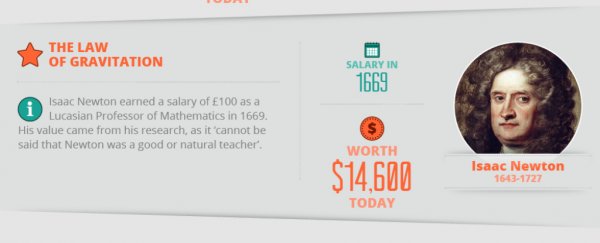Throughout history, scientists have totally changed the way we see the world. From the theory of general relativity that helps us understand our Universe to the discovery of radioactive elements used throughout medicine today, without the work of people like Albert Einstein and Marie Curie, the world would be a very different place.
But just how well compensated were these great minds for their pioneering research? Stephen Pritchard from Adzuna did some digging into the salaries of history's best-known scientists, and updated them to today's currency, based on inflation rates. And the results are pretty surprising.
Not only are the salaries overall pretty low when you consider just how influential these researchers were - Einstein earned the most at US$173,000, which is pretty impressive, until you compare it to what today's lawyers are earning - they're also incredibly inconsistent.
For example, while the undeniably impressive Galileo Galilei earned around US$141,155 back in the 1600s for his contributions to astronomy, German astronomer Caroline Herschel was only paid $7,199 for discovering eight comets in the late 1700s.
Obviously sexism was an issue back then, but even between the guys, things don't really add up, with astronomer Edwin Hubble earning just $20,559 in 1919.
But before you get too mad, a lot of that inconsistency can be explained by the fact that these salary estimates were taken at different points in each of the researchers' careers - and only reflect one year, not a lifetime, of earnings.
"Einstein's genius was well-established when he arrived at Princeton University for example, while Newton was almost 20 years away from publishing his theory on gravity," writes Pritchard.
Also, simply using inflation data to convert money from hundreds of years ago to today has its problems, so the comparisons aren't as straightforward as they appear.
But even as a rough guide, the infographic is still fascinating insight into how scientists were valued back in their day, and how our earnings today compare. You can see a zoomable version here.

